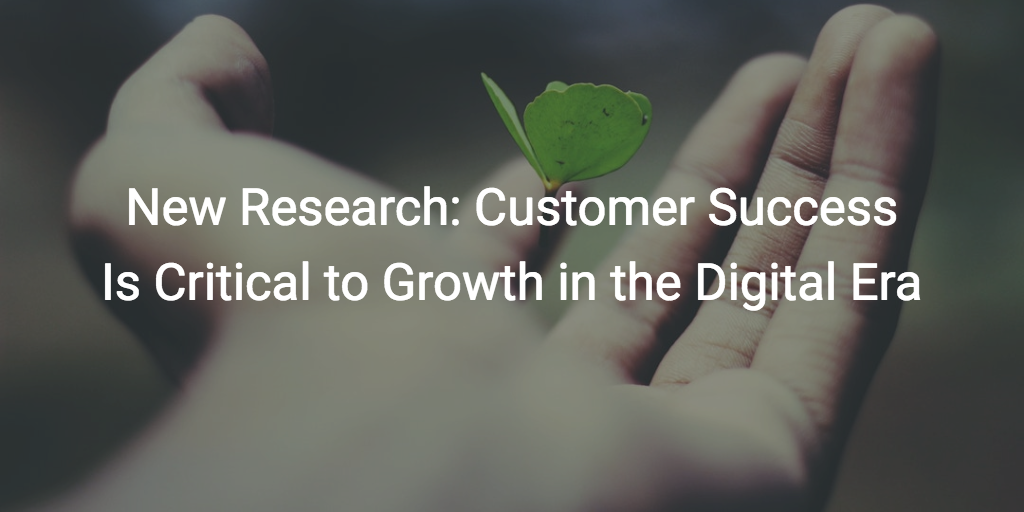How many of us have heard a business claim “our key differentiator is that we’re very focused on the customer?” And how often has that claim lined up with reality?
It’s one thing to say you’re customer-centric. It’s another to put it into practice.
Savvy business leaders have long understood that a certain level of customer-centricity is just table stakes. Fool me twice and all that. But that barebones level of focus on the customer usually translated into sporadic, pre-sale oriented, and ill-defined actions. Over the past few years, however, that’s changed rapidly. The rise of digital business has added urgency to—and rigor around—the concept of customer-centricity.
But one thing missing from this whole conversation on customer centricity, customer obsession, and customer success has been data. Is this happening in a way that can be measured? What are the actual figures around these trends? What’s the pace of change and what can we reasonably infer about the future?
To quantify the shift in the digital era, Gainsight commissioned Forrester Consulting to take a closer look at what they’ve dubbed “the age of the customer” and how today’s digital business climate has elevated customer success to a mission-critical growth function.
We invite you to read the study “Look To Customer Success To Drive Growth” to learn more. And to introduce the findings, we’ve highlighted some (but not all!) of the most exciting data below.
Most Businesses are Expanding Digital Offerings
“More than three-quarters of companies are currently offering or expanding their digital services or products and another 18% are planning to offer these services within the next 12 months.”
(Forrester has defined digital products and services as “software-driven or software-supported offerings that are sold as a subscription service and which customers can access through internet-connected devices.”)
The overwhelming majority of the 160 enterprises surveyed stated digital services were important to “better serve customers.” And this digital delivery underscores the need for an excellent post-sale experience. Subscription business models that go hand-in-hand with digital services make it easier than ever for customers to move spend elsewhere. The inverse is also true: new customers can more easily choose to partner with you.
For Digital Businesses, Customer Success Means Growth
“99% of companies with customer success see the value of the program for their business and their customers.”
Most digital businesses deal with a number of hurdles that can derail growth. Think: a ballooning number of digital product and service competitors, or complexity that impedes onboarding, adoption, and account growth. Risk factors abound and keeping a close eye on your customers’ health can be daunting. Let alone growing account footprints with new products or services.
This is precisely why customer success has become a non-negotiable part of the successful digital business’s playbook. The majority of businesses with a customer success function have seen improved retention and renewal rates—the baseline for exponential growth. The research found that specific benefits include: “a higher return on the customers’ investments and a partnership that helps customers achieve their business goals; access product roadmaps, development plans, or product teams; get personalized service; and achieve a faster time-to-value.”
And well beyond retention and maintenance, customer success is credited with increasing account values at more than half of the companies surveyed.
Perhaps most surprisingly, even those who have yet to embrace customer success see the value. Among organizations without a dedicated customer success function, 91% acknowledge that their customers suffer without the function in place.
Effective Customer Success Requires Change
“Ninety-seven percent of respondents without a customer success program said organizational hurdles like poor staffing and strategy held them back from implementing a program.”
Digital Business has challenged the status quo – but too often, the impulse is to minimize the change. This creates friction for companies evaluating customer success. Without tackling often difficult people, process, and technology questions, the function can be hobbled from the start or put on the backburner. And as we’ve uncovered, this can stymie revenue growth.
Putting the customer at the center of your business requires a deliberate customer success strategy and commensurate investment. To be a successful growth function, it requires careful alignment to the rest of the business, processes that create efficiency over time, and the right people to drive a new, strategic function forward. However, with so much upside, it’s worth the effort. And TSIA notes these factors can effectively be tackled incrementally.
Change also means investment in technology. Some 80% of businesses with customer success in place have invested in “technology and software to manage the customer success process and deliver value.” This allows more accurate customer health monitoring at scale through digital service delivery and triggers that help customer success professionals manage their time.
***
Be sure to read the full study. We’re excited to paint a data-backed picture of The Age of the Customer for digital businesses. It’s clear that we’ve entered a new era where customer success is not just important to revenue growth. It’s imperative.
Want to share what we’ve uncovered with a visual? You’re in luck:


